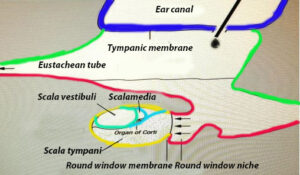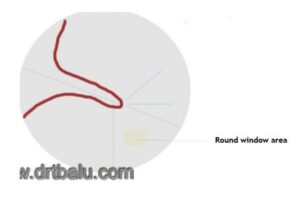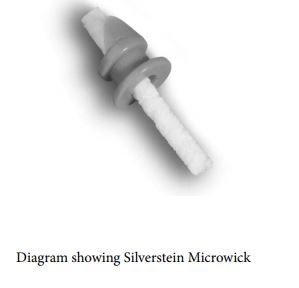Introduction:
Round window is considered to be the main gateway into the inner ear. Other possible gateways to inner ear include the oval window and the semicircular canals. Delivery of drug to the inner ear is possible via intratympanic route as it could percolate via the round window membrane. Intralabyrinthine injection can also be done via the semicircular canals also.
Stewart and Belal studied the surgical anatomy of round window in 1981. This study was performed in 271 temporal bones. This study revealed that the round window niche was like a triangular prism with the base at round window membrane and three walls. The mean horizontal diameter was 1.5 cm, while the mean vertical diameter was 1.2 mm. The entrance to the round window may be altered within the entrance or by structures outside the niche. A false round window membrane can be seen in nearly half of the temporal bones. Round window obstruction by fat/fibrous tissue are also possible in 20% of patients.
Schuknecht first used intra tympanic aminoglycosides (Streptomycin) for treatment of Meniere’s disease.
Because of its ototoxic effects this therapy had immediate effect on tinnitus. Beck later used gentamycin in
tinnitus management. This drug gained in popularity because of its ability to preserve hearing. Lignocaine
and steroids were also used with success in the management of tinnitus.
Target site:
If intra tympanic drug therapy is targetted at the basal turn of cochlea/or the vestibular system one shot of intratympanic medication administration would suffice. If the target site happens to be the apical portion of cochlea then multiple shots, pumps, catheters, biogradable polymers or cochleostomy may be needed.
Indications for intratympanic drug therapy:
1. Acute sensorineural hearing loss due to unknown cause, noise trauma, ototoxicity, ischemia, infection, head injury or auto-immune hearing loss.
2. Tinnitus not responding to conventional management
3. To treat vertigo due to Meniere’s disease
4. Can be used before acoustic neuroma surgery or cochlear implant surgery
Drugs used ion intratympanic therapy:
1. Corticosteroids (Dexamethasone is commonly used)
2. Aminoglycosides (gentamycin)
3. Xylocaine
4. Neurotransmitters for tinnitus
5. Apoptosis inhibitors for noise induced hearing loss, stem cell, gene vectors, and growth factors for hair cell loss
Factors determining the quantity of drug reaching the inner ear:
1. Concentration gradient
2. Round window membrane permeability
3. Contact period
4. Drug particle size
5. Electric charges
Major concern with intratympanic medication is the presence of round window false membrane and the fact that almost 90% of the drug injected goes down the Eustachean tube at the time of the injection. Another important variant in Intratympanic drug therapy is the technique of injection whether it is done by intratympanic, exploratory tympanotomy or transtympanic injection.
Intratympanic drug injection route:
1. Injection
2. Subannulus catheter
3. Exploratory tympanotomy
Transtympanic drug therapy is usually done by endoscopic assisted techniques using round window gelfoam / round window pumps.
Use of intratympanic lignocaine in the management of tinnitus:
Lignocaine belongs to a drug group called amides. Its mechanism of action is through sodium channel blockade at the level of neurons. It also has a profound analgesic, antiarrythmic and anticonvulsant properties. It has this unique ability to silence the hyperactive neurons responsible for the production of tinnitus.
Eventhough it was highly effective in the management of tinnitus, it had certain unpleasant side effects like vertigo, nausea and vomiting which necessitated hospitalisation of the patient.
Use of intratympanic corticosteriods in the management of tinnitus:
Corticosteriods are well known for its anti inflammatory property. Steriod receptors have been demonstrated in the inner ear. It
also increases the blood supply to the cochlea. It is this property which has been attributed as the cause for its effect on tinnitus.
The advantages of intra tympanic adminsitration of steriods is as follows:

1. When administered intra tympanically, it is devoid of its systemic toxic effects.
2. There is an immediate increase in concentration of this drug in the inner ear. There is virtually no latent period.
Methylpredinsolone has been found to have the best effect in the reduction of tinnitus because of its ability to penetrate into the
inner ear fluids though the round window membrane.
Factors influencing the passage of drugs through the round window:
1. Normal round window membrane
2. Presence of inflammation around round window membrane increases its permeability to the drug.
3. Obstruction due to eustachean tube block: This allows the drug to stay a long time within the middle ear cavity facilitating inner
ear penetration via the round window membrane.
4. Molecular weight of the drug administered: Lesser the molecular weight of the drug better is the penetration.
5. Liposolubility: The more liposoluble the drug the better is its penetration through the round window membrane.
Studies have shown that steriods have better effects in controlling the tinnitus caused by Meniere’s disease,
while lignocaine has better effect in controlling tinnitus associated with labyrinthine vertigo.
Dexamethasone can be perfused through the middle ear in a dose of 4mg/ml. This drug can be instilled into
the middle ear through a tympanotomy incision. Injections can be repeated once a week till the patient is
symptom free. Grommets can be introduced to facilitate repeated injections of this drug.
Gentamycin can be administered intra tympanically in doses of 40mg/ml. It can be repeated at weekly intervals till the patient is symptom free.
Modern middle ear drug delivery systems:
The aim of this delivery system is to predictably deliver drug directly over the round window membrane to
facilitate easy absorption. The Silverstein micro wick has been specifically designed for this purpose. The
main advantage of this system is that after the initial administration of the drug by the physician the patient
himself can administer the drugs at home at specified intervals. The microwick absorbs the medication and
transports it directly to the round window membrane.
The microwick is made up of polyvinyl acetate. It measures 1mm in diameter and about 9mm long. It can be
easily inserted through a grommet. As a first step grommet must be inserted into the round window area under local anesthesia. Round window niche is identified as a dark area just posterior and inferior to the umbo.
Microwick can easily be inserted through this ventilation tube in such a way that it lies in contact with the round window membrane. After the first administration of the drug patient himself can administer the drug as ear drops two or three times a day as advised. The only precaution is that the patient must lie with the drug adminstered ear facing up for at least 5 minutes to enable adequate drug perfusion into the middle ear. After treatment the microwick can easily be removed without anesthesia using a micro cup forceps.
Complications of intratympanic medications:
1. Intense giddiness
2. Vomiting
3. Middle ear infection
4. Residual perforation
Pitfalls of microwick therapy:
1. Accurate placement of the microwick over the round window area is a must.
2. Laser tympanotomy is preferred to conventional one because of the blood less field. This is a must for accurate placement of the wick. When the area is moist insertion of the wick becomes difficult because it swells up on exposure to moisture

